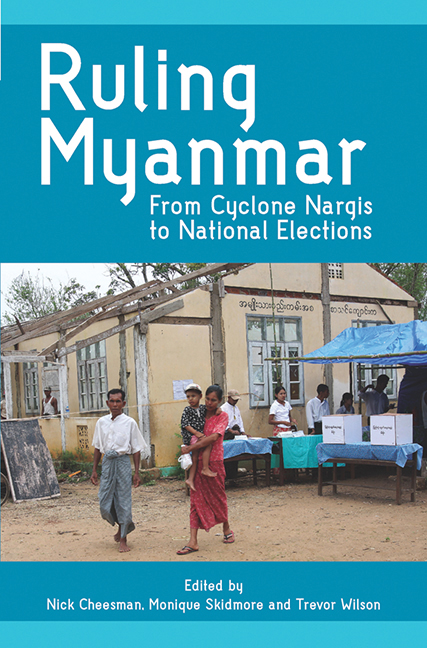Book contents
- Frontmatter
- Contents
- List of Tables
- List of Figures
- Background on ANU 2009 Myanmar/Burma Update Conference
- Acknowledgements
- Contributors and Editors
- Note on Terminology and Geographical Names
- Map of Myanmar
- Part I Overview
- Part II Political Legitimacy, Governance and Justice
- Part III Economic Development, the Rural Economy and Labour Rights
- Part IV The Role of International Cooperation and Governance
- 11 Cyclone Nargis and ASEAN: A Window for More Meaningful Development Cooperation in Myanmar
- 12 The Relief and Reconstruction Programme Following Cyclone Nargis: A Review of SPDC Policy
- 13 Positive Engagement in Myanmar: Some Current Examples and Thoughts for the Future
- 14 Normative Europe meets the Burmese Garrison State: Processes, Policies, Blockages and Future Possibilities
- 15 The Use of Normative Processes in Achieving Behaviour Change by the Regime in Myanmar
- List of Abbreviations
- Index
12 - The Relief and Reconstruction Programme Following Cyclone Nargis: A Review of SPDC Policy
from Part IV - The Role of International Cooperation and Governance
Published online by Cambridge University Press: 21 October 2015
- Frontmatter
- Contents
- List of Tables
- List of Figures
- Background on ANU 2009 Myanmar/Burma Update Conference
- Acknowledgements
- Contributors and Editors
- Note on Terminology and Geographical Names
- Map of Myanmar
- Part I Overview
- Part II Political Legitimacy, Governance and Justice
- Part III Economic Development, the Rural Economy and Labour Rights
- Part IV The Role of International Cooperation and Governance
- 11 Cyclone Nargis and ASEAN: A Window for More Meaningful Development Cooperation in Myanmar
- 12 The Relief and Reconstruction Programme Following Cyclone Nargis: A Review of SPDC Policy
- 13 Positive Engagement in Myanmar: Some Current Examples and Thoughts for the Future
- 14 Normative Europe meets the Burmese Garrison State: Processes, Policies, Blockages and Future Possibilities
- 15 The Use of Normative Processes in Achieving Behaviour Change by the Regime in Myanmar
- List of Abbreviations
- Index
Summary
INTRODUCTION
This chapter assesses the impact of the policy regime of Burma's ruling State Peace and Development Council (SPDC) on the relief and reconstruction programme that followed Cyclone Nargis, which struck lower Burma on 2–3 May 2008. The policy of the SPDC is only one determinant, albeit a critical one, of the success (or otherwise) of the aid effort. The chapter argues that its policy incompetence, neglect and brutality — hallmarks of the military regime more or less throughout its nearly 50-year rule — were once again evident in its response to the cyclone.
Of course, any analysis of the SPDC's role in the relief and reconstruction programme is limited by the availability and independence of public information, most of which derives from reports published by aid organizations. Given that one of the goals of aid organizations is to maximize the amount of donations received from the public and different governments, they have an incentive to censor information that might conflict with this goal. These same sources also frequently exaggerate the effectiveness of their projects (for the same motivation), while denying that problems arise from delivering aid under authoritarian systems of government of the sort in place in Burma.
The public information about the situation after Cyclone Nargis indicates that the aid programme was successful in averting famine in the face of widespread lost agricultural capacity in the delta. Yet, we also know that by the end of 2009 the situation for around one (of 2.4) million people severely affected by Cyclone Nargis had not returned to precyclone conditions (TCG 2009b). We know that many households were still unable to command enough resources to feed themselves or rebuild their assets, except by incurring increasing and unsustainable levels of debt (Soe Lwin 2009; TCG 2009b; WFP 2009). We know that the regime allocated minimal resources to the relief and reconstruction programme, with most of the projects being undertaken by NGOs and UN agencies (ACTED 2009; Merlin 2008). Moreover, available evidence also indicates that even the low levels of stock and quality of infrastructure and public goods that existed prior to Cyclone Nargis have not been replaced (IRIN 2009; JRCS 2009; TCG 2009b).
- Type
- Chapter
- Information
- Ruling MyanmarFrom Cyclone Nargis to National Elections, pp. 208 - 235Publisher: ISEAS–Yusof Ishak InstitutePrint publication year: 2010



